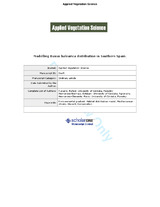Evaluating models to assess the distribution of Buxus balearica in southern Spain
Autor
Navarro Cerrillo, Rafael M.
Hernández Bermejo, Esteban
Hernández Clemente, Rocío
Editor
WileyFecha
2010Materia
Environmental gradientHabitat distribution model
Mediterranean shrubs
METS:
Mostrar el registro METSPREMIS:
Mostrar el registro PREMISMetadatos
Mostrar el registro completo del ítemResumen
uestion: Which is the best model to predict the habitat distribution of Buxus balearica Lam. in southern Spain?
Location: Málaga and Granada, Spain, across an area of 38 180 km2.
Methods: Prediction models based on 17 environmental variables were tested. Six methods were compared: multivariate adaptive regression spline (MARS), maximum entropy approach to modelling species' distributions (Maxent), two generic algorithms based on environmental metrics dissimilarity (BIOCLIM and DOMAIN), Genetic Algorithm for Rule-set Prediction (GARP), and supervised learning methods based on generalized linear classifiers (support vector machines, SVMs). To test the predictive power of the models we used the Kappa index.
Results: Maxent most accurately predicted the habitat distribution of B. balearica, followed by MARS models. The other models tested yielded lower accuracy values. A comparison of the predictive power of the models revealed that climate variables made the highest contributions among the environmental variables studied. The variables that made the lowest contributions were the insolation models. To examine the sensitivity of the models to a reduction in the number of variables, a test showed that accuracy of over 0.90 was maintained by applying just three climatic variables (spring rainfall, mean temperature of the warmest month, and mean temperature of the coldest month). Maps derived from the algorithms of all models tested coincided well with the known distribution of the species.
Conclusions: Model habitat prediction is a preliminary step towards highlighting areas of high habitat suitability of B. balearica. These data support the results of previous research, which show that MaxEnt is the best technique for modelling species distributions with small sample sizes.

